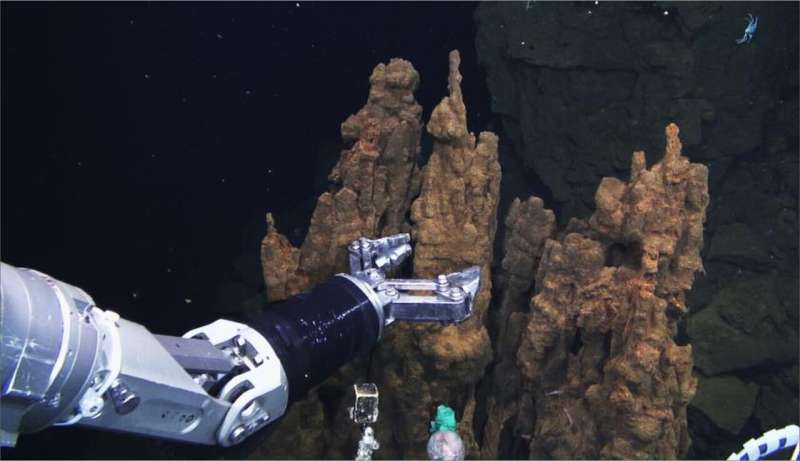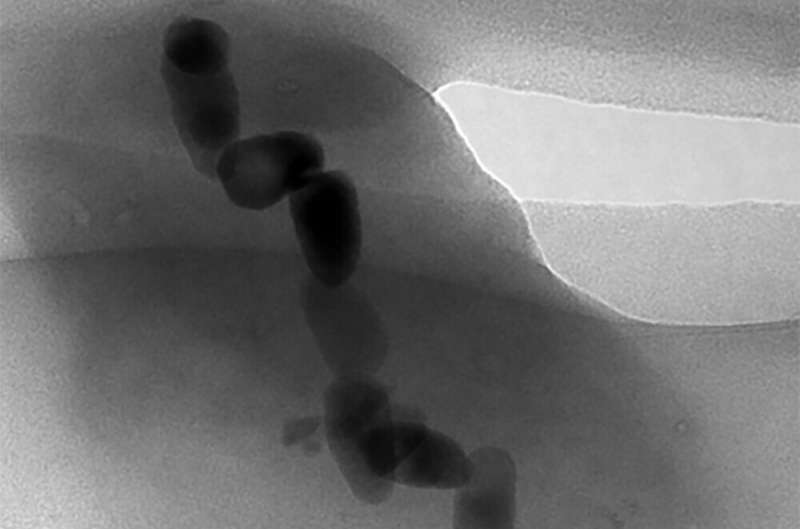
Magnetotactic bacteria, known for their ability to align with the Earth’s magnetic field, have been found in a surprising new location. Previously observed on land and in shallow water, these bacteria have now been discovered thriving deep under the ocean in a hydrothermal vent. This discovery challenges previous assumptions about their habitat requirements. The findings have been published in the journal Frontiers in Microbiology.
Magnetotactic bacteria are not only of interest for their ecological role on Earth, but also for their potential significance in the search for extraterrestrial life. Evidence of their existence can be preserved in rocks for billions of years. Additionally, their magnetic orientations can provide insights into the historical movement of the Earth’s magnetic poles. This new discovery raises hopes that magnetic bacteria may be found in even more unexpected locations, both on Earth and potentially on other celestial bodies such as Mars.
Magnetotactic bacteria possess unique abilities; they can “sense” and align with the Earth’s magnetic field. These microscopic organisms contain magnetosomes, which are iron crystals enveloped by a membrane. These magnetosomes align themselves with the Earth’s magnetic field, functioning like a compass and guiding the bacteria in a north or south direction along the Earth’s magnetic field lines, much like trains on a magnetic track.
These bacteria play a crucial role in the biogeochemical cycling of essential elements such as carbon, nitrogen, and phosphorous in nature. While they have been extensively studied on land and in shallow water, their behavior in deep water environments has remained a challenge to investigate and understand.
In September 2012, a team of researchers from the University of Tokyo embarked on an oceanic research expedition to explore the southern Mariana Trough in the western Pacific Ocean. Using a remotely operated underwater vehicle named HYPER-DOLPHIN, they collected a “chimney” from a hydrothermal vent field located 2,787 meters underwater. Hydrothermal vents form when seawater percolates deep into the earth and is superheated by magma, resulting in the deposition of minerals and metals into the ocean. Over time, these deposits build up to form chimneys, creating a warm and rich habitat for a variety of unique life forms.

“We unexpectedly discovered magnetotactic bacteria living on the chimney. The shape of the chimney does not provide a clear vertical chemical gradient, which is typically preferred by these bacteria,” explained Associate Professor Yohey Suzuki from the Graduate School of Science at the University of Tokyo. “The bacteria we collected primarily had ‘bullet’-shaped magnetosomes, which we consider to be a ‘primitive’ form. This led us to infer that these bacteria have remained relatively unchanged over many millennia. Interestingly, the environment in which we found them resembles early Earth approximately 3.5 billion years ago, which is estimated to be when the ancestor of magnetotactic bacteria emerged.”
The bacteria were collected from the rim of the chimney using a magnet. The researchers then examined the genetic data and discovered that the bacteria were related to a group of bacteria known as Nitrospinae. Nitrospinae bacteria are known for their role in carbon fixation in deep-sea environments, but until now, they were not known to contain any magnetotactic groups.
“Deep-sea hydrothermal vents not only serve as habitats for unique underwater life, but they also have the potential to be analogous environments for extraterrestrial life,” said Suzuki. “The environment where we collected the bacteria is similar to what we believe Mars was like when liquid water existed on its surface approximately 3 billion years ago.”
Fossilized remains of magnetic particles, known as magnetofossils, from magnetotactic bacteria can be preserved in rocks for billions of years. These magnetofossils can offer valuable insights into ancient geomagnetic history and are promising targets in the search for signs of extraterrestrial life.
In 1996, the Martian meteorite Allan Hills 84001 sparked global interest when it appeared to contain fossilized iron crystals resembling bacteria. Although the claim has since been widely debated, Suzuki remains hopeful for future discoveries.
“Magnetotactic bacteria provide hints about the early diversification of bacteria, and we believe it is possible to find them beyond Earth, perhaps on Mars or icy moons. For now, our focus is on searching for more evidence of their presence in various types and ages of rocks on Earth, where they were not previously thought to exist.”
More information:
Bullet-shaped magnetosomes and metagenomic-based magnetosome gene profiles in a deep-sea hydrothermal vent chimney., Frontiers in Microbiology (2023). DOI: 10.3389/fmicb.2023.1174899
Citation:
Magnetic bacteria provide clues for the early diversification of bacteria (2023
Denial of responsibility! TechCodex is an automatic aggregator of the all world’s media. In each content, the hyperlink to the primary source is specified. All trademarks belong to their rightful owners, and all materials to their authors. For any complaint, please reach us at – [email protected]. We will take necessary action within 24 hours.

Jessica Irvine is a tech enthusiast specializing in gadgets. From smart home devices to cutting-edge electronics, Jessica explores the world of consumer tech, offering readers comprehensive reviews, hands-on experiences, and expert insights into the coolest and most innovative gadgets on the market.
Denial of responsibility! TechCodex is an automatic aggregator of Global media. In each content, the hyperlink to the primary source is specified. All trademarks belong to their rightful owners, and all materials to their authors. For any complaint, please reach us at – [email protected]. We will take necessary action within 24 hours.


